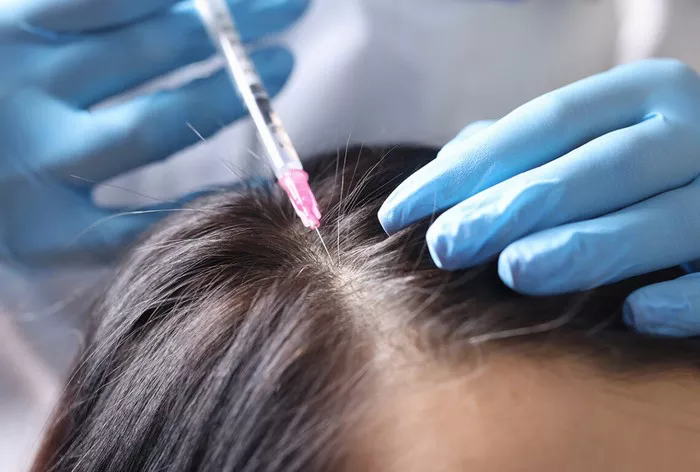Hair transplantation is a popular solution for individuals experiencing hair loss. It involves moving hair from one part of the body (donor site) to the bald or thinning area (recipient site). There are various types of hair used in hair transplantation, each with its own characteristics and suitability for different types of hair loss. This article will explore the 6 primary types of hair used in hair transplantation, providing an easy-to-understand, objective, and professional overview.
1. Scalp Hair
Donor Dominance and Natural Look
Scalp hair is the most commonly used type of hair in hair transplantation. This hair is typically taken from the back and sides of the scalp, where hair is usually more resistant to balding. This phenomenon is known as donor dominance. Transplanting scalp hair provides the most natural look, as it matches the texture, color, and growth pattern of the recipient area.
Suitability and Techniques
Scalp hair is suitable for almost all patients experiencing hair loss on the scalp. The two primary techniques used for scalp hair transplantation are Follicular Unit Transplantation (FUT) and Follicular Unit Extraction (FUE). Both methods involve transplanting hair follicles in groups of one to four hairs, mimicking natural hair growth.
Advantages
Natural appearance
High success rate
Matches existing scalp hair
Disadvantages
Limited donor area
Potential for noticeable scarring in FUT
2. Beard Hair
Characteristics and Usage
Beard hair is another viable option for hair transplantation, especially for individuals with limited scalp donor hair. Beard hair tends to be coarser and thicker than scalp hair, making it ideal for adding density to areas requiring more coverage, such as the crown or areas with extensive hair loss.
Techniques and Compatibility
The FUE technique is commonly used to extract beard hair. Beard hair can be blended with scalp hair for a fuller appearance, but it may require more meticulous planning to ensure a natural look due to the difference in texture and growth patterns.
Advantages
Abundant supply in individuals with thick beards
Effective for adding density
Disadvantages
Coarser texture may not blend seamlessly with scalp hair
Potential for different growth patterns
See Also: 7 Reasons Why Your Hair Transplant Doesn’t Look Good
3. Body Hair
Sources and Application
Body hair, including hair from the chest, back, and legs, can be used in hair transplantation when scalp and beard hair are insufficient. Body hair is typically finer and shorter, which can be advantageous for certain applications but may not provide the same density as scalp hair.
Extraction and Integration
Body hair is also extracted using the FUE technique. It is often used to supplement scalp hair, particularly in patients with extensive hair loss. The success of body hair transplantation largely depends on the compatibility of the donor hair with the recipient area.
Advantages
Additional donor source for patients with limited scalp and beard hair
Can be used to achieve specific aesthetic goals
Disadvantages
Different texture and growth cycle
Lower density compared to scalp hair
4. Leg Hair
Specific Uses and Considerations
Leg hair is another type of body hair used in hair transplantation. It is generally finer and less dense than scalp or beard hair. Leg hair can be particularly useful for transplanting into areas requiring finer hair, such as the hairline or temples.
Techniques and Integration
The FUE technique is used for extracting leg hair. Due to its finer texture, leg hair can create a soft and natural-looking hairline, but it may not be suitable for areas requiring high density.
Advantages
Fine texture ideal for creating a natural hairline
Additional donor source for patients with limited scalp hair
Disadvantages
Lower density
Different growth cycle
5. Chest Hair
Characteristics and Suitability
Chest hair is another viable option for hair transplantation. It is usually coarser than scalp hair but can provide good coverage and density for certain areas. Chest hair is often used in combination with other types of hair to achieve the desired result.
Extraction and Application
The FUE technique is also used for chest hair extraction. Chest hair can be particularly useful for adding density to the crown or other areas where thicker hair is beneficial.
Advantages
Abundant in individuals with thick chest hair
Effective for adding density
Disadvantages
Coarser texture may not blend seamlessly with scalp hair
Different growth cycle
6. Arm Hair
Uses and Characteristics
Arm hair is less commonly used in hair transplantation but can be a viable option in certain cases. It is generally finer than chest or beard hair, making it suitable for areas requiring finer hair.
Techniques and Integration
As with other body hair types, the FUE technique is used for arm hair extraction. Arm hair can be used to create a soft, natural-looking hairline or to add subtle density to thinning areas.
Advantages
Fine texture ideal for creating a natural hairline
Additional donor source for patients with limited scalp hair
Disadvantages
Lower density
Different growth cycle
Conclusion
Hair transplantation has evolved to include various types of hair, each with unique characteristics and applications. Understanding the differences between scalp, beard, body, leg, chest, and arm hair can help patients and surgeons achieve the best possible results. Each type of hair has its advantages and disadvantages, and the choice of donor hair should be tailored to the individual needs of the patient. By carefully selecting and combining different types of hair, hair transplantation can provide natural-looking and satisfying outcomes for those experiencing hair loss.
In summary, the six types of hair used in hair transplantation—scalp hair, beard hair, body hair, leg hair, chest hair, and arm hair—offer diverse options for addressing various degrees and patterns of hair loss. The selection of donor hair is crucial for achieving the desired aesthetic result, and advancements in techniques such as FUE have made it possible to utilize these different hair types effectively. Whether aiming to restore a receding hairline, add density to thinning areas, or achieve a fuller crown, understanding the characteristics of each hair type is essential for successful hair transplantation.
Related topics:

